Cittadella (Gozo)
| Cittadella | |
|---|---|
| Iċ-Ċittadella | |
| Victoria, Gozo, Malta | |
|
View of the Cittadella from the east | |
|
Map of the Cittadella | |
 Cittadella | |
| Coordinates | 36°2′47″N 14°14′22″E / 36.04639°N 14.23944°ECoordinates: 36°2′47″N 14°14′22″E / 36.04639°N 14.23944°E |
| Type | Citadel |
| Site information | |
| Owner |
Government of Malta Various private owners |
| Open to the public | Yes |
| Condition | Intact |
| Site history | |
| Built |
c. 1500 BC (first fortifications) 15th century – 1622 (present fortifications) |
| Built by |
Crown of Aragon Order of Saint John |
| In use | c. 1500 BC – 1868 |
| Materials | Limestone |
| Battles/wars |
Invasion of Gozo (1551) Capture of Gozo (1798) |
| Garrison information | |
| Past commanders | Gelatian de Sessa (attack of 1551) |
The Cittadella (Maltese: Iċ-Ċittadella), also known as the Citadel, the Castello (Maltese: Il-Kastell) or the Gran Castello, is a citadel in Victoria, on the island of Gozo in Malta. The area has been inhabited since the Bronze Age. The present configuration of the Cittadella is a combination of a medieval castle and an early modern gunpowder fortress, with its northern walls retaining a largely medieval form and its southern walls dating back to a 17th-century reconstruction. The Cittadella has been included on Malta's tentative list of UNESCO World Heritage Sites since 1998.[1]
History
Prehistory and antiquity
Although there is only limited evidence of Neolithic remains in the Cittadella or Victoria, it is likely that the area has been inhabited since the Stone Age, given its size and strategic position. Archaeological remains show that the site of the Cittadella was definitely inhabited during the Bronze Age, in the Tarxien Cemetery and Borġ in-Nadur phases of Maltese prehistory.[2]
The Victoria area remained the main settlement on Gozo throughout the Phoenician and Roman periods, and it became a settlement known as Gaulos or Glauconis Civitas. The city consisted of an acropolis on the site of the Cittadella, and a fortified town in an area now occupied by part of Victoria. A temple dedicated to Juno is said to have stood on the site now occupied by the cathedral. A number of architectural fragments from Gaulos have survived,[3] including a 2nd-century AD Latin inscription on a limestone block that was reused in the main gate of the Cittadella.[2]
Several remains of walls which might have formed part of the Punic-Roman fortifications of Gaulos have been discovered. In 1969, traces of massive walls were discovered during building works in Main Gate Street (Maltese: Triq Putirjal), to the south of the Cittadella.[2] Further remains were discovered just outside the Cittadella during an archaeological excavation in 2017.[4]
Medieval period
During the medieval period, the Roman town was abandoned, and the acropolis was transformed into a castle. The first reference to the castrum of Gozo dates back to 1241. It was sacked by the Genoese in 1274, and a report on its fortifications was ordered two years later. At this point, one-third of Gozo's population lived in or around the Cittadella, and the island's inhabitants were required to spend the night within the citadel. By the end of the 13th century, the Cittadella housed some Sicilian or Italian noblemen representing the Count of Malta. The Cittadella was called terra by the mid-14th century, and an administrative council known as the Università was founded in 1350.[2]
Over time, the Cittadella became too small for the growing population, and by the 15th century the suburb of Rabat began to develop on the site of the Roman town. This settlement was surrounded by a wall with three gates known as Putirjal, Bieb il-Għajn and Bieb il-Għarb.[2] At this point Malta and Gozo were ruled by the Crown of Aragon, and the Cittadella's fortifications were strengthened.
Hospitaller rule

Malta and Gozo were handed over to the Order of St. John in 1530. At the time, the Cittadella was still a medieval castle which provided refuge for the Gozitans during Ottoman or Barbary attacks.[5]
The largest attack on the Cittadella took place in July 1551, when a large Ottoman force led by admiral Sinan Pasha invaded Gozo and besieged the Cittadella. Governor Gelatian de Sessa offered terms of surrender, but they were refused and the castle fell within a matter of days. It was sacked and most of the 6,000 Gozitans who took refuge there were taken as slaves. The attack left the castle as a ruin, and it was rebuilt soon afterwards although initially no efforts were made to modernize it.[5]
The Cittadella was not attacked during the Great Siege of Malta in 1565. Although there had been proposals to demolish the castle and evacuate its inhabitants to Sicily, the castle served an important role during the siege, as it maintained a communication link between besieged Birgu and Christian vessels, and it also reported Ottoman movements to the Order.[2]
After the siege, Grand Master Jean Parisot de Valette and military engineer Francesco Laparelli visited the Cittadella in order to modernize it, but nothing materialized since at the time the Order was busy constructing its new capital Valletta on mainland Malta. The Cittadella was attacked again by corsairs in 1583.[2]
In 1599, a major reconstruction of the Cittadella begun to designs of the military engineer Giovanni Rinaldini and under the direction of Vittorio Cassar. The southern walls of the city were completely rebuilt as a bastioned enceinte with a single bastion and two demi-bastions linked by curtain walls, along with two cavaliers, a ditch and outworks.[5] Parts of the northern walls were also rebuilt by the Hospitallers, although they retained a medieval form.[6] The walls surrounding the suburb Rabat were probably demolished at this point. The reconstruction to Rinaldini's and Cassar's designs was completed in around 1622.[2]
Gozo's population stayed within the walls of the Cittadella between dusk and dawn until this curfew was lifted on 15 April 1637.[7] The castle remained the only fortified refuge against attack for the island's inhabitants until Fort Chambray was built in the mid-18th century.[8]
Soon after the reconstruction was complete, the Cittadella's defences were again criticized. In the 1640s, plans were made to demolish the citadel and build a new fortress at Marsalforn. Mines were actually built under the bastions to destroy them if necessary, but the demolition was never done.[9] The engineer Antonio Maurizio Valperga suggested to rebuild the wall around the suburb and further strengthen the Cittadella, but there were no funds for this proposal.[2]
By the early 18th century, the Cittadella had assumed the role of a fortress, with many of its houses falling into ruin or being in a poor state. An attack on Gozo took place in 1708, and in 1715 the engineer Louis François d'Aubigné de Tigné made the same suggestions as Valperga, but a lack of funds prevented any work from being carried out.[2]
French occupation and British rule
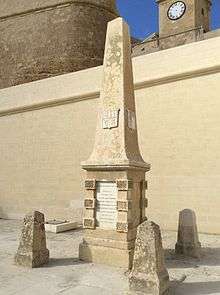
In June 1798, the Maltese islands were occupied by the French, but the Maltese revolted after a couple of months of French rule. The Gozitans rebelled on 3 September, and the French garrison withdrew to the Cittadella, until they capitulated on 28 October after some negotiations. A day later, the British transferred control of the Cittadella to the Gozitans, who set up a provisional government led by Saverio Cassar and briefly administered the island as the independent state La Nazione Gozitana.[10]
The fortifications of the Cittadella were decommissioned by the British on 1 April 1868. The Cittadella's fortifications and the ruined buildings within the city were included on the Antiquities List of 1925.[11]
Several World War II-era air raid shelters were dug within the Cittadella.[2]
Recent history

The Cittadella's fortifications, including part of the medieval enceinte, are intact. The southern part of the city, where the cathedral and other buildings are located, is also in good condition, but the northern part is largely in ruins. Many of these ruins date back to the medieval period, and they contain archaeological deposits.[1]
In 2006, the first plans were made to restore the Cittadella, as part of a project that also includes the restoration of the fortifications of Valletta, Birgu and Mdina on mainland Malta.[12] Restoration began in 2008 and was re-inaugurated in 2016.[13][14]
Throughout the course of restoration, various architectural features and archaeological remains have been unearthed, including the city's original entrance.[15][16] Hence, some of the original plans for the regeneration of the Citadel had to be modified.[17]
Architecture
The Cittadella is built on a promontory overlooking the present day city of Victoria. This location was originally chosen because it is a naturally defensible hill, dominating the surrounding countryside and having views of large parts of the coastline.
Fortifications

The fortifications of the Cittadella consist of a semi-circular enceinte in the northern end of the city, and bastions linked together with curtain walls in the south. The northern walls are built on the perimeter of the natural plateau, so they were difficult to attack. They were originally built in the 15th century, although large portions of the walls were rebuilt by the Hospitallers or in modern times. The northern walls include the remains of a collapsed medieval wall tower, a blocked-up sally port,[18] a lookout post and some walled-up windows.[6] Masonry revetments are built in depressions within the cliff face below the northern walls.[19]
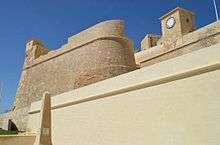
The southern perimeter of the city consists of a 17th-century bastioned enceinte which was built by the Hospitallers. A large arrowhead-shaped bastion known as St. Michael's Bastion is built at the southernmost end of the city, while two demi-bastions – St. Martin's and St. John's Demi-Bastions – are located at the west and east ends of the city. Flat-roofed echauguettes are built on the salient of each demi-bastion.[20][21] St. Michael's Bastion also had an echaugette but this was replaced by a clock tower in 1858.[22] A small gunpowder magazine is located at the junction between St. John's Demi-Bastion and the medieval enceinte.[23]
The bastions are linked together by curtain walls. The one between St. Martin's Demi-Bastion and St. Michael's Bastion contains the Main Gate,[24] a modern arched opening and a clock tower.[25] The wall between St. Michael's Bastion and St. John's Demi-Bastion is known as St. Philip's Curtain,[2] and its upper part contains slit-like openings which open into a series of magazines which are now used as craft shops. These rooms support a walkway along the ramparts.[26][27]
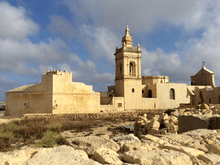
Cavaliers were also built close to each demi-bastion. St. Martin's Cavalier is located between the medieval enceinte and St. Martin's Demi-Bastion, and it is only partially intact, its upper portions having been pulled down.[28][29] St. John's Cavalier, which is found near St. John's Demi-Bastion and the rear of the cathedral, was completed in 1614. A freestanding room was constructed on its roof in 1701 for use as a gunpowder magazine.[30]
A pentagonal artillery battery known as the Low Battery is grafted below the walls at the easternmost extremity of the fortress, close to St. John's Demi-Bastion.[31] The southern perimeter of the Cittadella is surrounded by a ditch, which originally extended from St. Martin's Demi-Bastion to the Low Battery but now begins at St. Michael's Bastion due to 19th-century alterations.[32] A covertway with a single place-of-arms runs along the ditch.[33] A steep glacis was located outside the covertway, but this has been built up.[5]
A small triangular ravelin stood near the entrance to the city, but this has lost most of its stonework and has been converted into a garden, losing its legibility as part of the fortress in the process.[34]
Churches
One of the major landmarks in the Cittadella is the Cathedral of the Assumption, which is the seat of the Roman Catholic Diocese of Gozo. According to tradition, it stands on the site of a Roman temple dedicated to Juno, which was eventually converted to a Christian church dedicated to the Virgin Mary. It is believed to have been destroyed after the Maltese islands fell to the Arabs. A second church was built in the medieval period, and the earliest mentions of a parish church within the Cittadella date back to the 13th century. This church was enlarged in the 15th and 16th centuries, and it was damaged in the 1551 attack although it was repaired within a few years. The building was damaged during the 1693 Sicily earthquake, and it was subsequently demolished to make way for the present structure, which is a Baroque building constructed between 1697 and 1711 to designs of Lorenzo Gafà,[35] a Maltese architect who also built the Cathedral of Mdina on mainland Malta. Extensive remains of a Roman temple were found during construction,[36] and some remains from this era still survive beneath the cathedral.[37] The church became a cathedral with the establishment of the diocese of Gozo in 1864. Today, the building is most famous for a remarkable trompe l'oeil on its ceiling, which depicts the interior of a dome that was never built.[38] This was painted by the Sicilian artist Antonio Manuele.[39] A small building behind the cathedral currently houses the Cathedral Museum.[40]

Two chapels are also found inside the Cittadella. The Chapel of St. Joseph, known as ta' fuq is-sur ("on the bastions"), was originally built in around the 11th century, and it was dedicated to Nicholas of Bari. The present building was built in 1625, possibly to designs of Vittorio Cassar, and it might incorporate parts of the original chapel.[41]
The other chapel is dedicated to Saint Barbara, and it is known as "within the Walls". Its site was originally occupied by a chapel dedicated to John the Baptist, but this was deconsecrated in 1575.[38] The site was given to the Confraternity of St. Barbara in 1598, who built the current chapel in the early 17th century, during the magistracy of Alof de Wignacourt and around the same time when the fortifications were being reconstructed. This chapel is annexed to the cathedral.[42]
Other chapels dedicated to Saint Lawrence and Our Saviour existed within the Cittadella during the medieval period. These were deconsecrated following Inquisitor Pietro Dusina's visit in 1575, and no remains have survived today.[38]
Other buildings
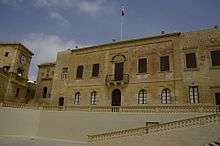
The main square of the Cittadella, which is known as Pjazza tal-Katidral (Cathedral Square), contains the Law Courts. These are housed in two buildings, one of which was purpose-built as a courthouse, and another which was formerly the Governor's Palace,[43] built in the early 17th century.[44] Opposite the Governor's Palace is the Bishop's Palace.[45] Adjoining the Chapel of St. Joseph, there is a residential palace that was built by Bishop Baldassare Cagliares in 1620.[46]
A number of other buildings are currently open to the public as museums:
- The Old Prison, located behind the Law Courts, which was used as a prison from the 16th century to 1962. It contains well-preserved prison cells and other exhibitions.[47]
- The Natural Science Museum, which is dedicated to Gozo's geography, geology and natural science. It is located within a group of 17th-century houses which at times had been used as an inn.[48]
- The Gozo Museum of Archaeology, which is dedicated to Gozitan history from the prehistoric to medieval periods,[49] is located within a 17th-century house that was originally known as Casa Bondi.[50]
- Gran Castello Historic House, which is dedicated to Gozitan folklore. It is housed in a cluster of early 16th century houses.[51]
These four museums are run by Heritage Malta.
References
- 1 2 "Cittadella (Victoria – Gozo)". UNESCO Tentative List. Archived from the original on 30 April 2016.
- 1 2 3 4 5 6 7 8 9 10 11 12 "Environmental Planning Statement for the Creation of Stabilised Slopes and Car Parking at Rabat, Gozo – Responses to MEPA and other stakeholders' comments" (PDF). Malta Environment and Planning Authority. Fgura. August 2012. pp. 28–47, 236–237. Archived from the original (PDF) on 29 March 2015.
- ↑ Pericciuoli Borzesi, Giuseppe (1830). The historical guide to the island of Malta and its dependencies. Malta: Government Press. p. 83–84.
- ↑ Carabott, Sarah (11 May 2017). "Ancient walls uncovered just outside Ċittadella". Times of Malta. Archived from the original on 12 May 2017.
- 1 2 3 4 "Cittadella" (PDF). National Inventory of the Cultural Property of the Maltese Islands. 28 June 2013. Archived from the original (PDF) on 13 July 2016.
- 1 2 "Medieval enceinte – Cittadella" (PDF). National Inventory of the Cultural Property of the Maltese Islands. 28 June 2013. Archived from the original (PDF) on 13 July 2015.
- ↑ "History". Victoria Local Council. Archived from the original on 2 April 2016.
- ↑ Buhagiar, Konrad; Cassar, JoAnn (2003). "Fort Chambray: The genesis and realization of a project in eighteenth-century Malta" (PDF). Melita Historica. 13 (4): 347–364. Archived from the original (PDF) on 22 March 2016.
- ↑ "Restoration of the Cittadella". MilitaryArchitecture.com. Retrieved 6 March 2015.
- ↑ Schiavone, Michael J. (2009). Dictionary of Maltese Biographies A–F. Malta: Publikazzjonijiet Indipendenza. pp. 533–534. ISBN 9789993291329.
- ↑ "Protection of Antiquities Regulations 21st November, 1932 Government Notice 402 of 1932, as Amended by Government Notices 127 of 1935 and 338 of 1939.". Malta Environment and Planning Authority. Archived from the original on 19 April 2016.
- ↑ Zammit, Ninu (12 December 2006). "Restoration of forts and fortifications". Times of Malta. Archived from the original on 3 March 2016.
- ↑ "Ambitious Citadel restoration project". Times of Malta. 10 August 2008. Archived from the original on 24 November 2016.
- ↑ Cocks, Joanne (10 December 2012). "Gozo's Cittadella getting €6m restoration". Times of Malta. Archived from the original on 24 November 2016.
- ↑ Dalli, Kim (21 June 2014). "Original entrance to Gozo Citadel exposed". Times of Malta. Archived from the original on 24 November 2016.
- ↑ Spiteri, Stephen C. (14 July 2014). "Unearthed features at the Cittadella". MilitaryArchitecture.com. Archived from the original on 14 May 2017.
- ↑ "Gazzetta tal-Gvern ta' Malta" (PDF). Government Gazette. 23 January 2015. p. 585. Archived from the original (PDF) on 23 November 2016.
- ↑ "Medieval sally-port on north enceinte – Cittadella" (PDF). National Inventory of the Cultural Property of the Maltese Islands. 28 June 2013. Archived from the original (PDF) on 24 January 2016.
- ↑ "Masonry revetments along the foot of the cliff face – Cittadella" (PDF). National Inventory of the Cultural Property of the Maltese Islands. 28 June 2013. Archived from the original (PDF) on 13 July 2016.
- ↑ "St Martin Demi-bastion – Cittadella" (PDF). National Inventory of the Cultural Property of the Maltese Islands. 28 June 2013. Archived from the original (PDF) on 13 July 2015.
- ↑ "St John Demi-Bastion – Cittadella" (PDF). National Inventory of the Cultural Property of the Maltese Islands. 28 June 2013. Archived from the original (PDF) on 14 July 2015.
- ↑ "St Michael Bastion – Cittadella" (PDF). National Inventory of the Cultural Property of the Maltese Islands. 28 June 2013. Archived from the original (PDF) on 13 July 2015.
- ↑ "Gunpowder Magazine – Cittadella" (PDF). National Inventory of the Cultural Property of the Maltese Islands. 28 June 2013. Archived from the original (PDF) on 13 July 2016.
- ↑ "Main gate – Cittadella" (PDF). National Inventory of the Cultural Property of the Maltese Islands. 28 June 2013. Archived from the original (PDF) on 13 July 2016.
- ↑ "Curtain wall linking St Martin Demi-bastion to St Michael Bastion – Cittadella" (PDF). National Inventory of the Cultural Property of the Maltese Islands. 28 June 2013. Archived from the original (PDF) on 13 July 2016.
- ↑ "Curtain wall linking St John Demi-bastion to St Michael Bastion – Cittadella" (PDF). National Inventory of the Cultural Property of the Maltese Islands. 28 June 2013. Archived from the original (PDF) on 13 July 2016.
- ↑ "Magazines (Craft Shop)" (PDF). National Inventory of the Cultural Property of the Maltese Islands. 28 December 2012. Archived from the original (PDF) on 13 July 2016.
- ↑ Spiteri, Stephen C. (2013). "In Defence of the Coast (I) – The Bastioned Towers". Arx – International Journal of Military Architecture and Fortification (3): 70–74. Retrieved 26 April 2015.
- ↑ "St Martin Cavalier – Cittadella" (PDF). National Inventory of the Cultural Property of the Maltese Islands. 28 June 2013. Archived from the original (PDF) on 13 July 2015.
- ↑ "St John Cavalier – Cittadella" (PDF). National Inventory of the Cultural Property of the Maltese Islands. 28 June 2013. Archived from the original (PDF) on 13 July 2015.
- ↑ "Low Battery – Cittadella" (PDF). National Inventory of the Cultural Property of the Maltese Islands. 28 June 2013. Archived from the original (PDF) on 13 July 2015.
- ↑ "Ditch – Cittadella" (PDF). National Inventory of the Cultural Property of the Maltese Islands. 28 June 2013. Archived from the original (PDF) on 15 November 2015.
- ↑ "Covertway – Cittadella" (PDF). National Inventory of the Cultural Property of the Maltese Islands. 28 June 2013. Archived from the original (PDF) on 13 July 2016.
- ↑ "Ravelin – Cittadella" (PDF). National Inventory of the Cultural Property of the Maltese Islands. 28 June 2013. Archived from the original (PDF) on 14 July 2015.
- ↑ "Cathedral of the Assumption of the Madonna" (PDF). National Inventory of the Cultural Property of the Maltese Islands. 27 August 2012. Archived from the original (PDF) on 18 August 2016.
- ↑ "Rabat – Katidral". Gozo Diocese. Archived from the original on 23 March 2016.
- ↑ Mallia, Steve (22 December 2003). "Roman wall unearthed at Gozo cathedral". Times of Malta. Archived from the original on 4 March 2016.
- 1 2 3 Scerri, John. "Rabat (Victoria)". malta-canada.com. Archived from the original on 24 December 2016.
- ↑ Bezzina, Joseph (16 August 2009). "Trompe l'oeil at Gozo Cathedral". Times of Malta. Archived from the original on 5 June 2017.
- ↑ "Cathedral Museum" (PDF). National Inventory of the Cultural Property of the Maltese Islands. 28 December 2012. Archived from the original (PDF) on 22 August 2016.
- ↑ "Church of St Joseph" (PDF). National Inventory of the Cultural Property of the Maltese Islands. 27 August 2012. Archived from the original (PDF) on 21 August 2016.
- ↑ "Church of Sta Barbara" (PDF). National Inventory of the Cultural Property of the Maltese Islands. 27 August 2012. Archived from the original (PDF) on 19 August 2016.
- ↑ "Law Courts" (PDF). National Inventory of the Cultural Property of the Maltese Islands. 28 December 2012. Archived from the original (PDF) on 19 August 2016.
- ↑ "The Courts". The Judiciary of Malta. Archived from the original on 17 October 2016.
- ↑ "Bishop's Palace" (PDF). National Inventory of the Cultural Property of the Maltese Islands. 28 December 2012. Archived from the original (PDF) on 22 August 2016.
- ↑ "Cagliares Palace" (PDF). National Inventory of the Cultural Property of the Maltese Islands. 28 December 2012. Archived from the original (PDF) on 18 August 2016.
- ↑ "The Old Prison". malta.com. Archived from the original on 16 October 2016.
- ↑ "Natural Science Museum" (PDF). National Inventory of the Cultural Property of the Maltese Islands. 28 December 2012. Archived from the original (PDF) on 18 August 2016.
- ↑ "Archaeology Museum". Reach Malta. Archived from the original on 2 November 2016. Retrieved 15 May 2017.
- ↑ "Archaeology Museum" (PDF). National Inventory of the Cultural Property of the Maltese Islands. 28 December 2012. Archived from the original (PDF) on 22 August 2016.
- ↑ "Gran Castello Historic House (Folklore Museum)". Heritage Malta. Archived from the original on 14 May 2017.
External links
| Wikimedia Commons has media related to Cittadella (Gozo). |
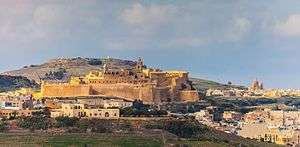
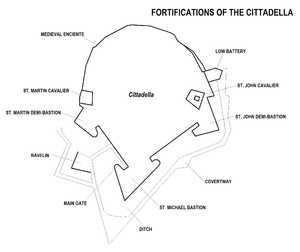
_and_stairs.jpeg)

.svg.png)